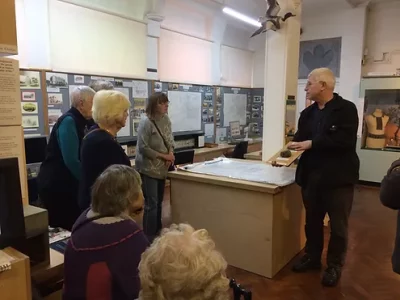Insight to Culture

InSight to Culture is an Arts Council England funded project, encouraging members of the local community who are living with impaired vision to connect with Bexhill Museum's collection in an innovative & creative way. Bexhill Museum is always looking to progress the accessibility of the displays on show to the public within the galleries. The programme was devised by local artist Colin Heminway, and led by him supported by Claire Buckley.
The project aims to research ideas through: experience, discussion and creative activities which will lead to display and interpretation initiatives that provide a more fulfilling experience for all visitors to the museum. Regular afternoon sessions at the museum allow participants to explore the galleries with Curator Julian Porter, and have the opportunity to handle and experience objects from the museum's stored collection.
Artist-led workshops relating to each of the three main galleries' collections encourage participants to form creative responses to their experience of museum artefacts. We would like to thank all those who have offered to take part in the project and to the local charities Hastings and Rother Voluntary Association for the Blind (HRVAB), and Homecall for their support. There's more information and updated content on Colin's project blog - click the button below
A project in action - video
Adapting to needs

Whilst exploring the galleries there was the chance to talk about experiences past and present of interacting with displays in museum settings. The balance between conservation and accessibility of the artefacts was discussed, both necessary requirements of museum custodians, but often conflicting ones. The members of the group have varying degrees of sight loss. Some resulting from life long conditions, and others having developed disorders such as macular degeneration. A repeated frustration voiced was interpretation and object labels inside of glass display cabinets. These, no matter the font size and colour formats proved difficult to read because of light reflections on the cabinet glass from the gallery environment.
One intervention tried was the use of pen torches. Participants were offered the torches to carry with them through the galleries and invited to explore the displays using the torchlight. Response was positive. Light shone into the case illuminated objects to a greater extent, allowing them to be appreciated and the small torches enabled individuals to navigate the cases at their discretion. The torches are a low cost equipment item and being rechargeable have little on going maintenance cost. Using LED technology, the torch has a low risk light contamination impact on the museum objects and the lightweight plastic body is unlikely to cause damage to display cases if accidentally dropped. It is planned to make the torches available at the museum reception for future visitors who may which to use them.
Close Inspection of Objects
One workshop session allowed project members to handle objects from the stored collection that are not on public display. The museum pieces were chosen for their appearance and construction, either shaped by human or naturally formed. The items selected were considered durable enough to be safely handled without using protective gloves and participants were encouraged to study the objects by touch to examine the detail and gain an understanding of the physicality of the artefacts.

In addition a selection of magnifiers and targeted light sources were available to use. Julian provided contextual information about the artefacts, which represented collections of natural history, archaeology, world culture and British folk art.
A discovery from the museum stores was a small collection of early 20th century Milagros and these formed a starting point for the next workshop. These small, embossed tin pieces, believed to be Maltese in origin are traditionally given as votive offerings to aid healing or bring safe fortune. Typically a custom of South American and the Iberian Peninsula cultures, a Milagro (Spanish for miracle) is left in a place of worship to accompany a prayer.
Using the embossed technique of the Milagros as a starting point, participants were encouraged to create their own embossed designs. Using sheets of thin foil and a selection of marking tools, members produced an array of exciting results. A brave start to the creative workshops as the embossing technique does not allow rubbing out mistakes!
Coping with COVID
During the lockdown period there was great emphasis on digital interaction, but for our project ‘going digital’ was neither practical for all those involved or complementary to the project's aim. We were exploring ways of making the museum more accessible to sight impaired visitors, not contributing to a problem.

We decided that if the participants couldn’t come to the museum, we would take the project to them. Julian and costume collection manager Georgina Bradley carefully selected items that would be suitable for members to study on their own and in their homes. The objects were individually packed in bespoke travel boxes along with contextual descriptions recorded onto audio devices by Julian and Georgina.
Following the required safety measures, project participants were delivered an object at their home. They were encouraged to explore the item handling it and listening to the recorded description provided. They were then asked to produce a response to their experience of the object. Following guidance, participants were instructed to find an object or item that they had in their home that bore some relation to the museum piece, something which would form a connection if the two were placed side by side.
The outcomes of their choices and decisions were recorded by telephone conversations with participants in the weeks that followed. Extracts of these exchanges have been compiled together along with narratives of the museum objects selected. This audio montage re-unites the project during a period of remote working.
Thank you
We would like to thank all those who have offered to take part in the project and to the local charities Hastings and Rother Voluntary Association for the Blind (HRVAB), and Homecall for their support. Thank you to Arts Council England who provided much appreciated funding for this project.











